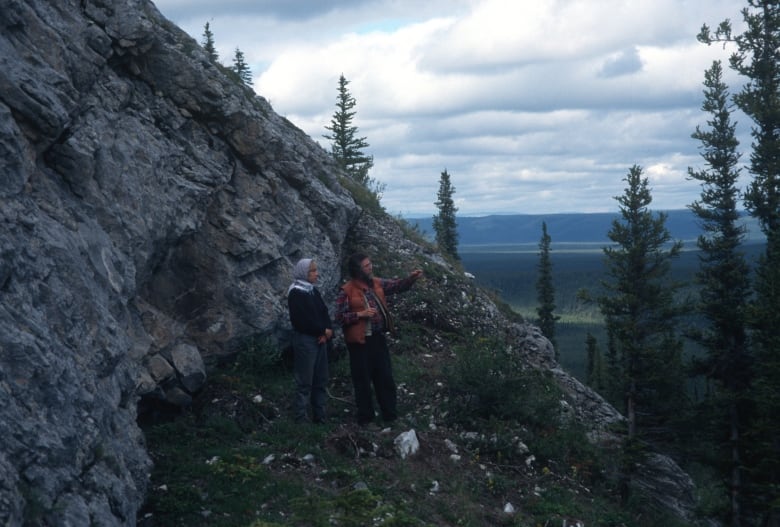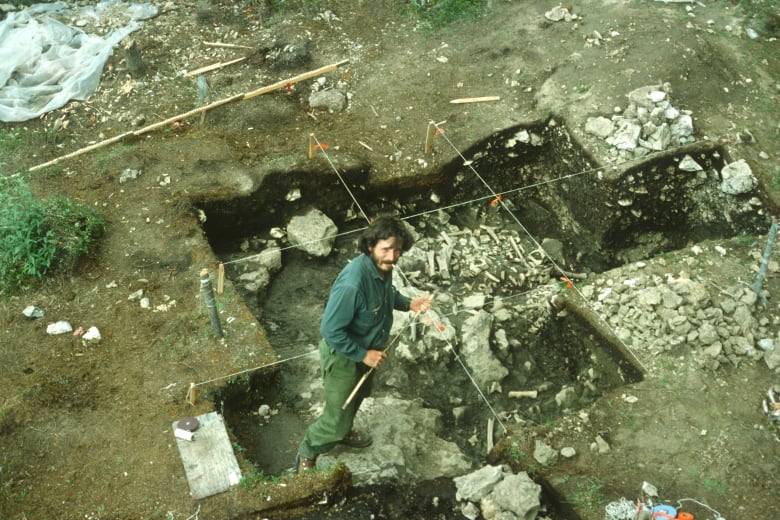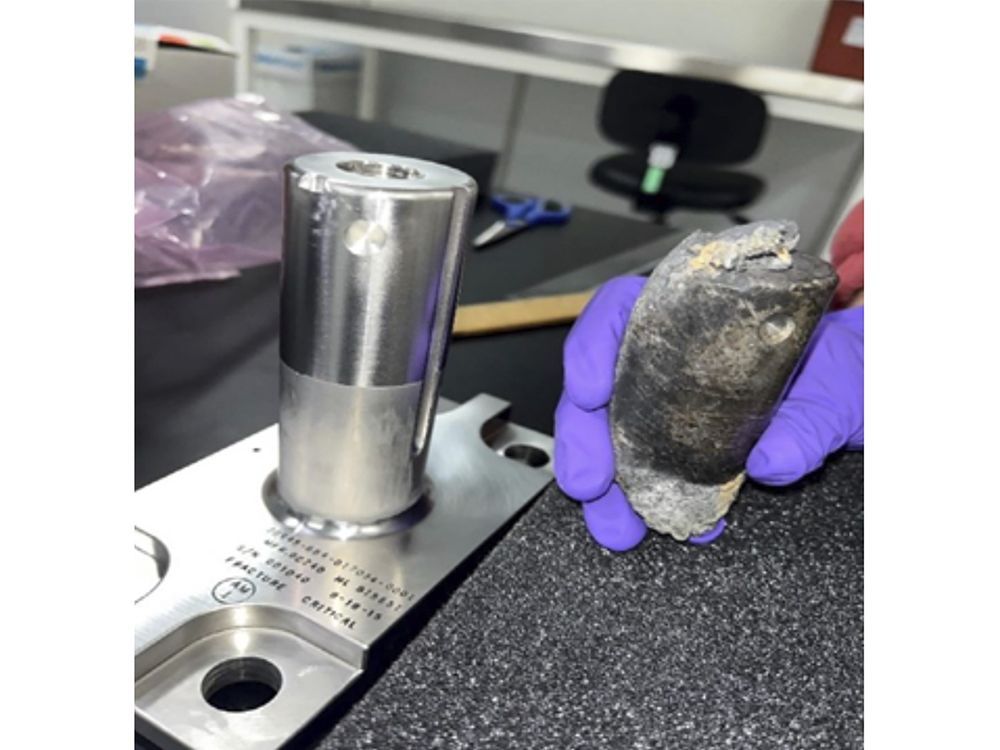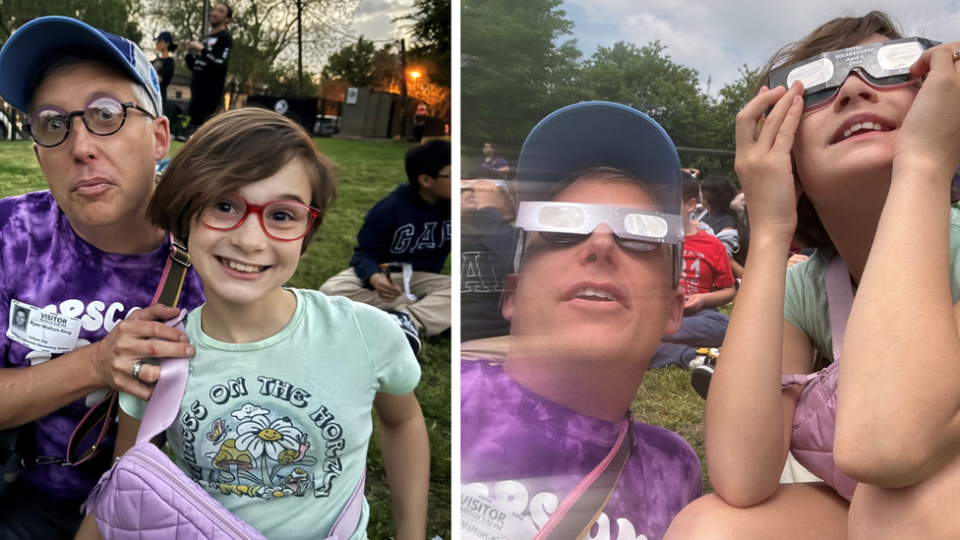Science
Archaeologist whose research in Yukon made waves in science world remembered – CBC.ca


The archaeologist best known for his work in Yukon’s Bluefish Caves where he found that human beings set foot in North America much earlier than originally thought, died Nov. 27. He was 79.
Jacques Cinq-Mars discovered that humans were in the Yukon 24,000 years ago instead of the scientifically accepted notion for a long time that it had only been 13,000 years.
It made him an unpopular figure in the research community for a time.
Cinq-Mars worked for the Canadian Museum of History, where he began many of his research trips in the Old Crow area, beginning in the early 1970s.
That’s when Elder William Josie of the Vuntut Gwitchin First Nation in Old Crow, Yukon, first met him. Josie was around 12 or 13 years old at the time.
Josie said Cinq-Mars got along well with the locals he met, and that his research helped with his community’s land claim negotiations.
“It really helped us, you know,” he said. “Our people, we took less money for more land that means a lot to us. And, you know, the elders that time said, we won’t regret it. And we definitely don’t today.”
Josie described him as a “very passionate guy.”
“He sort of took us under his wing and he taught us a lot,” he said. “I really appreciate that.”
“I will remember him as a good teacher and mentor.”
A colleague of Cinq-Mars, Yukon archaeologist Ruth Gotthardt, said she first met Cinq-Mars in 1975, while she was an undergraduate student at the University of Toronto.
‘His best legacy’
Cinq-Mars and Bill Irving had just started up the northern Yukon research program and were looking for students to help them catalog collections.
At the time, Gotthard was a second-year archaeology student and was “desperate” to get her hands on some real archaeology, so she volunteered.
“He was very gruff,” she remembers with a laugh.
“He didn’t suffer fools gladly. He was very intimidating in terms of you know, you would ask questions, and he would say, ‘well, that’s a stupid question.'”
But when he did answer questions, he knew “so much,” she said.
Gotthardt said she wasn’t surprised when Cinq-Mars announced the findings at bluefish dated to 24,000 years ago, because she was there.
“We were all thinking, this is really worth entertaining that human beings came not after the last ice age, but you know, during the last ice age at some point, and we figured, ‘well, why not?'” Gotthardt said.
She said she’ll remember Cinq-Mars’s curiosity about the world.
“It’s his interest in everything, right?” she said. “He’s worked at such a range of different sites [in Yukon],” Gotthardt said.
She said he not only “had so much knowledge,” but he also encouraged other researchers to work in the area too.
“His kind of scholarly … energy that encourages others to do research and expand the research, I think, is what I’ll remember about him,” she said.
“I think that’s his best legacy.”
‘Never only about him’
For his son, Eric Cinq-Mars, the scientist was something of a role model.
“My dad is pretty much someone that my brother and I looked up to,” Eric said.
While Cinq-Mars was “very kind and generous” to his sons, Eric said, he was that way toward others in his life, including citizens of the Gwich’in community, with whom he spent a lot of time. Eric said he had the chance to go to Yukon to see his father’s work in 1998 and 1999.


He remembers the interactions between his dad and the community elders as one of mutual “utmost respect.”
“I think that it was very reciprocal. I think they very much enjoyed each other’s company, to say the least,” Eric said.
When it comes to the ripples his father made in the science world with his Bluefish Caves findings, he said he always remained sure of himself.
“My father was a very stubborn man,” Eric said. “He had to fight for his results. But, in the end, he was always quite clear about how accurate his research was.”
And several years later, when Cinq-Mars was proved to be right about his initial findings that humans were in Yukon 24,000 years ago, Eric said it was soothing for him.
“My father was quite happy to know that he was finally recognized within the scientific community, yet, he always knew that he was right,” Eric said.
“For him, archeology was a passion obviously … but he was a very kind and human and gentle person who enjoyed sharing with others,” Eric said.
“It was never only about him.”
Cinq-Mars leaves behind his wife, Andrée Favre, and his two sons, Marc and Eric Cinq-Mars.
Science
NASA is seeking a faster, cheaper way to bring Mars samples to Earth – CityNews Toronto


CAPE CANAVERAL, Fla. (AP) — NASA’s plan to bring samples from Mars back to Earth is on hold until there’s a faster, cheaper way, space agency officials said Monday.
Retrieving Mars soil and rocks has been on NASA’s to-do list for decades, but the date kept moving forward, as costs ballooned. A recent independent review put the total cost at $8 billion to $11 billion, with an arrival date of 2040, about a decade later than advertised.
NASA Administrator Bill Nelson said that’s too much and too late. He’s asking private industry and the space agency’s centers to come up with other options to revamp the project. With NASA facing across-the-board budget cuts, he wants to avoid gutting other science projects to finance the Mars sample project.
“We want to get every new and fresh idea that we can,” he said at a news conference.
NASA’s rover Perseverance already has gathered 24 core samples in tubes since landing in 2021 at Mars’ Jezero Crater, an ancient river delta. The goal is more than 30 samples to scour for possible signs of ancient Martian life.
The space agency wants to get at least some of the collected samples to Earth sometime in the 2030s for no more than the $7 billion. That would require a spacecraft that goes to Mars to get the tubes and launches off the planet. Then it must rendezvous with yet another spacecraft that would bring the samples to Earth.
NASA’s science mission chief, Nicky Fox, refused to speculate at the news conference when the samples might arrive at Earth, given a new program and timeline, or even how many samples might be returned. That information will be included in any proposals, she said.
“We’ve never launched from another planet, and that’s actually what makes Mars sample return such a challenging and interesting mission,” Fox said.
Scientists are eager to analyze pristine samples from Mars in their own labs, far superior to the kind of rudimentary testing done by spacecraft at the red planet. It will take such in-depth testing to confirm any evidence of microscopic life dating back billions of years when water flowed on the planet, according to NASA.
The samples will help NASA decide where astronauts go on Mars in the 2040s, Nelson said.
NASA’s Jet Propulsion Laboratory in Pasadena, California, had been in charge of the sample project. It was hit by hundreds of layoffs earlier this year due to all the budget cutbacks. Nelson is seeking ideas from across the space agency, with the revamped program more spread out.
NASA hopes to receive any ideas by late fall.
___
The Associated Press Health and Science Department receives support from the Howard Hughes Medical Institute’s Science and Educational Media Group. The AP is solely responsible for all content.
Marcia Dunn, The Associated Press
Science
NASA confirms mystery object that crashed through roof of Florida home came from space station – Toronto Sun


Article content
NAPLES, Fla. (AP) — NASA confirmed Monday that a mystery object that crashed through the roof of a Florida home last month was a chunk of space junk from equipment discarded at the International Space Station.
Article content
The cylindrical object that tore through the home in Naples on March 8 was subsequently taken to the Kennedy Space Center in Cape Canaveral for analysis.
Article content
The space agency said it was a metal support used to mount old batteries on a cargo pallet for disposal. The pallet was jettisoned from the space station in 2021, and the load was expected to eventually fully burn up on entry into Earth’s atmosphere, but one piece survived.
The chunk of metal weighed 1.6 pounds (0.7 kilograms) and was 4 inches (10 centimetres) tall and roughly 1 1/2 inches (4 centimetres) wide.
Homeowner Alejandro Otero told television station WINK at the time that he was on vacation when his son told him what had happened. Otero came home early to check on the house, finding the object had ripped through his ceiling and torn up the flooring.
“I was shaking. I was completely in disbelief. What are the chances of something landing on my house with such force to cause so much damage,” Otero said. “I’m super grateful that nobody got hurt.”
Share this article in your social network
Science
Total solar eclipse: Continent watches in wonder – Yahoo News Canada
Across Mexico, the US and Canada, inside a ribbon of land stretching 155 miles wide but more than 4,000 miles long, tens of millions of people craned their necks, tilted their heads to the sky and watched in wonder as the day turned to night.
What many saw on Monday was a phenomenon like no other: the Moon moving between the Earth and the Sun, extinguishing its light in a total solar eclipse.
The path of totality spanned the continent, beginning over the warm sands of a Mexican beach town and darkening the skies above the crashing waters of Niagara Falls before ending its journey on the shores of Canada’s Newfoundland.
It left a sense of awe in its wake, a reminder of our planet’s place in the universe.
The eclipse was first seen around Mazatlán, Mexico, on the country’s western shores at 11:07 local time (18:07 GMT).
At first, the Moon’s outer edge seemed to just be touching the Sun. Then it devoured more and more until cheers erupted as all finally went dark – save for the silvery glow of the “corona” effect of the Sun around the Moon’s outline.

A thousand miles away in Dallas, Texas, 11-year-old Ady Walton-King was waiting, weeks of pent-up excitement ready to burst.
She had learned all about the eclipse in her fifth-grade class at Dallas Academy and on Monday morning she laced up her shoes and tucked four pairs of eclipse glasses into her pink purse – one for herself, one for each parent and one for her little sister, Abigail.
Just before it started, Ady sat down beside her dad, Ryan, on a school field in central Dallas and lifted her gaze upward.
And then it happened.
It all felt slow, she said, as she described the Texas afternoon turning dark. “It looked like the Moon was biting the Sun, but without the teeth marks.”
Clouds slid in and out, occasionally blocking the eclipse from view until the Sun had vanished, nothing left but little flares of light around the Moon.
“I didn’t think it would be like that,” Ady said. “It was really dark out. I thought it would be like evening dark, but it was pretty close to pitch black.”
The temperature dropped suddenly and, just as she had been taught, animals fell silent.
“As it started to get lighter the crickets were there, and the birds started singing. It was really crazy,” she said. “I’m sad it’s over.”
From there, the eclipse moved on, carving its path north-east through the United States.
For some, the solar phenomenon was marked by a personal milestone, with hundreds of Americans joining one of several mass wedding events dotted across the path of totality.


In Russellville, Arkansas, 300 couples from across the country signed up, saying “I do” just before the sky went black. As the sky brightened, the group cut wedding cakes and danced – all part of the aptly named Total Eclipse of the Heart festival.
Following the Moon one state over, in Ellsinore, Missouri, was amateur astronomer Darcy Howard, who had driven from her home in central Arkansas to be sure bad weather didn’t block her view.
She had seen many eclipses before today, two totals, one annular and two partials. “Each one has its own fingerprint,” she said.
Totality today, at around 13:56 local time (18:56 GMT) brought an “eerie twilight”, Ms Howard said, with dusky colours dotted all along the horizon. The corona was nearly as bright as a full moon. “The sense of other-worldliness was all around,” she said.
The 70-year-old has loved the cosmos since her childhood, since her father showed her the Big Dipper, the North Star and the Milky Way, and bought her her first telescope.
“I was hooked,” she said. “I can look through a telescope and see Jupiter… I can see Saturn. And when I see that in space, I know all is right with the world.”


By 15:13 local time (20:13 GMT), the total eclipse had plunged the midwestern state of Ohio into darkness.
In Cleveland, where eclipse-watchers were graced by clear skies, the Sun’s corona was clearly visible, a brilliant halo framing the Moon.
The stars came out in the middle of the day, a sight met with cheers and fireworks, a mid-April New Years Eve.
Many big American cities were not lucky enough to be on the path of totality – but the spectacles were still awe-inspiring. In New York, hundreds of people crowded on to the viewing platform of the Edge skyscraper in Manhattan to see what they could see.
They did not leave disappointed as the sun shrank to a crescent-like sliver of light that cast an unearthly pale gloom over the city.


Tourists had crowded along both sides of the border at Niagara Falls, where the eclipse path crossed from the US into Canada.
Here, the weather offered a formidable challenge, with thick grey clouds mostly obscuring the sky from view.
But just in time for totality – to the audible delight of the crowd – the clouds parted to reveal the black-hole Sun.
Nearby, on a Niagara City Cruise, 309 people celebrated by record-breaking – dressing up as the Sun to break the Guinness World Record for “Largest gathering of people dressed as the Sun”.
The relentless motion of the heavenly bodies meant that the phenomenon did not last long, and it was Montreal that next got its chance to be plunged into temporary night.
In Montreal, 20,000 people crowded onto a field on McGill University’s campus for an event held by the school’s Trottier Space Institute.
“We had been expecting 8,000,” programme administrator Caroina Cruz-Vinaccia said after. The weather was perfect, clear and bright skies. At the moment of totality, the crowd erupted at once, she said.
“I still can’t quite find the words for how cool this was,” she said. “We’re still coming down.”
Crowds were smaller on Newfoundland’s Fogo Island, on Canada’s east coast – one of the last places the totality could be viewed.
Bethany Downery, a Newfoundland native who works for the European Space Agency, tuned into the spectacular view from the Fogo Island Inn, nestled right against the Atlantic Ocean.
The skies were overcast, she said, but the clouds moved miraculously in time to catch near totality.
And with that, a day of collective wonder and celebration reached its conclusion. But it had left a permanent mark on many of those who had witnessed it.
In Dallas, a few thousand miles back along the path, Ady Walton-King was making plans.
Texas will not be in the path of totality again for another 300 years, so she’ll have to travel for the next one in North America, in 2044.
And by that time, she’ll be even more of an expert on total eclipses. “I want to be a scientist by the time that happens,” she said.
– With additional reporting from Brandon Livesay, Nada Tawfik, Nadine Yousif and Helena Humphrey


More on the solar eclipse
-
Media17 hours ago
DJT Stock Plunges After Trump Media Files to Issue Shares
-
Business16 hours ago
FFAW, ASP Pleased With Resumption of Crab Fishery – VOCM
-
Media16 hours ago
Marjorie Taylor Greene won’t say what happened to her Trump Media stock
-
Business17 hours ago
Javier Blas 10 Things Oil Traders Need to Know About Iran's Attack on Israel – OilPrice.com
-
Media15 hours ago
Trump Media stock slides again to bring it nearly 60% below its peak as euphoria fades – National Post
-
Business22 hours ago
A government mortgage policy that makes sense – with one glaring question – The Globe and Mail
-



 Politics17 hours ago
Politics17 hours agoIn cutting out politics, A24 movie 'Civil War' fails viewers – Los Angeles Times
-
Media18 hours ago
Trump Media Plunges After Registering Shares, Warrants for Sale – BNN Bloomberg





